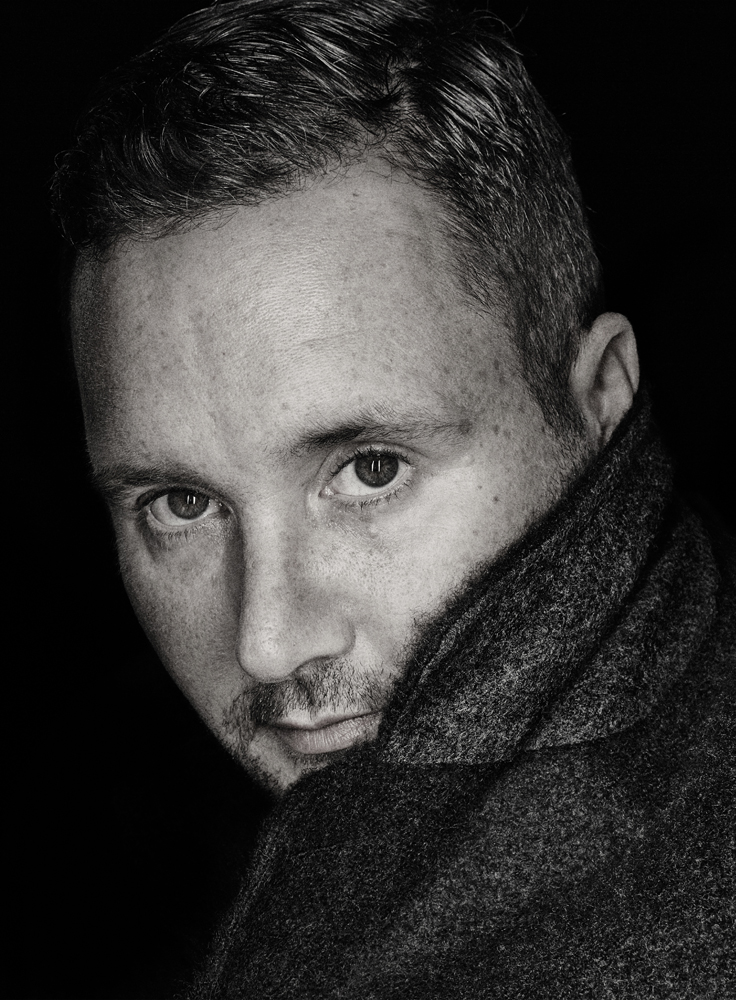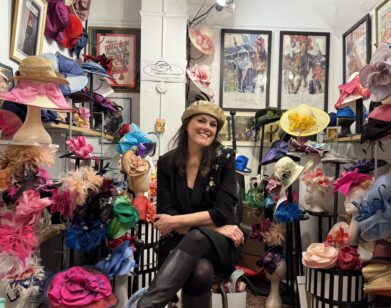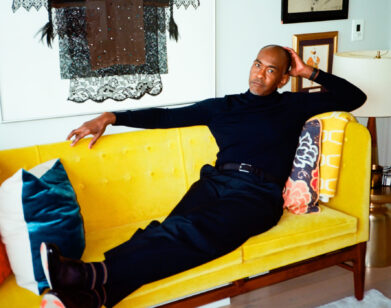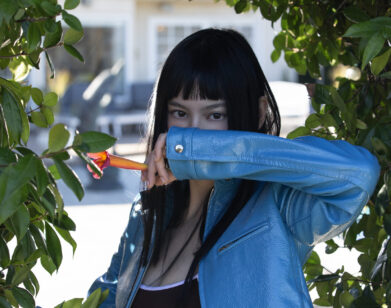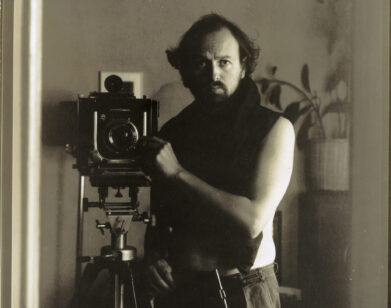Kim Jones
i like to tell stories and i like to look at different parts of the world. for me, it’s more about looking at amazing cultures and seeing how they have inspired a huge amount of the world without people even realizing it. Kim Jones
Kim Jones moves quickly, and he moves a lot. Born in London to a Danish mother and English father, Jones was on the road at only 3 months old, when he and his family moved to Ecuador. He really hasn’t stopped moving since. His father was a hydrogeologist and, at various points in Jones’s youth, relocated the family to the Caribbean, Kenya, Ethiopia, Tanzania, and Botswana, where the young Jones developed his first crush on a garment—a tee with a picture of a lion. He returned to England as a teen and, after inheriting his sister’s collection of fashion magazines, precocious as he is, found his life’s passion at 14.
Jones is known as something of a street-style savant, with particular affinities for streetwear, for Japanese takes on Americana, and for the vibrant fashion tribes of London’s nightlife—and many of these affinities began for him around this time. In college, he studied graphics and photography at Camberwell School of Art, and then enrolled in the famous graduate program in fashion at Central Saint Martins, studying menswear. John Galliano bought half of his 2002 thesis collection.
Like a lot of travelers, Jones has always been something of a collector. One area of focus is the eccentric fashions of 1980s London clubland, but he’s not flipping any of it on eBay—the only piece he’s sold for money, a Vivienne Westwood parachute shirt, funded his first collection in 2003. And, in the eight seasons he ran his own line, Jones continued to move, designing for Umbro, Iceberg, Hugo Boss, Alexander McQueen, and Kanye’s Pastelle, before taking over at Dunhill in 2008.
A few years later—only ten years removed from grad school—he landed his dream job, a job almost cartoonishly well-suited to his particular set of skills, the men’s artistic director at Louis Vuitton. Perhaps unsurprisingly, the obsessive traveler with a globe’s worth of references has flourished at the house with wanderlust in its DNA, a house founded on a steamer trunk.
In a way, his process isn’t in itself revolutionary. Most designers burn through references and inspirations the way jet-setters do fuel, and Vuitton is such a monolithic empire—the most valuable luxury brand in the world—that it can, like all empires, easily and gleefully welcome and assimilate a broad array of exotic influences without losing its own identity. But it is the content of Jones’s references—specifically the streetwear he grew up admiring, imitating, and then pioneering—that has made a profound impact on luxury menswear. He and his generation have been at the vanguard of a major shake-up in men’s fashion, reimagining tailoring with nontraditional techniques, and bringing streetwear staples into the luxury lexicon.
And still he is on the prowl—still roaming the globe with the stated intention of visiting every country in the world—and bringing home all his wondrous finds. As Jones tells his pal Nick Jonas, there is so much more to see and do.
NICK JONAS: What, in your mind, is the relationship between music and fashion? How has music informed your creative life?
KIM JONES: Well, all of my collections start with a piece of music that I’m thinking about. And then I work backwards, because music has been integral to my life since I was a kid. I’ve never been a musician, but I’ve worked with lots of people in music, like Nile Rodgers, Giorgio Moroder, and Michael Stipe, for the music that we’ve done for shows and things. And I love the formatting, the way it can create emotions and ideas, and putting that into the context of how you develop a collection and make the mood for a show—it’s a big thing. Lots of my friends are musicians. I’m always talking about music. I have a huge vinyl collection of rare stuff that I’ve collected over the last 20 years. I talk to lots of people about it and sample bits and these enter all sorts of parts of my work really.
JONAS: What are some of the favorite vinyl records you have in your collection?
JONES: I have a few records that belonged to Larry Levan, who was the DJ at the Paradise Garage, and some very rare acetate, like Pop Your Funk by Arthur Russell and stuff like that. There are probably only ten of those records in the world. And then this Stevie Wonder 12-inch that they only made a hundred of. It’s mainly soul, but it goes all the way across to techno and rock and hip-hop and everything that I like. I’ve got probably 6,000 records or so. A lot of it you can’t find anywhere else. It’s not on CDs, not on the internet. You have to go back to the source, which is what I do a lot with my work, really.
JONAS: In music and in fashion, there is this constant cycle that happens. Some things released are on the cutting edge, and years later come back and are not only influential, nostalgic in a way, but also feel very fresh.
JONES: That excites me, that mix of classic and youth culture. I’ll take something old, take something new, mix it together and see what you get. I guess when you make music, you think of the image of what you want to portray from the soul. I quite often look at our shows and think what the final video of it would be rather than the actual experience in real time.
JONAS: The whole picture. When I approach the writing of an album, I can tell pretty early on what the final product is going to be. I’ll play the first demo for my team and say, “Listen, I think it’s going to head in this direction.” And at first they may think I’ve lost the plot. [laughs] But I think when you are doing your best work, it’s when people question what the fuck you’re thinking. So it’s nice when you can really step out and do something different. But the crazy thing for me that’s different between music and fashion is that, when you’re working with a brand, there are times that your personal taste has to take a backseat. Because I’m sure that there are times that you’ve done something for the greater good of the brand but which doesn’t fall within the range of things that you’d wear.
JONES: Yeah. I don’t really think about me necessarily when I’m working on the brand, because Louis Vuitton has, like mastered this. It’s like Coca-Cola. There’s some of me in the collections. But the overriding thing is the brand itself. I feel like I’m doing an interpretation, through Louis Vuitton, of myself. And that’s the thing that I enjoy. I like working with a team of people, collaborating to make something relevant to lots of people in different ways. And you have these really good things to work with, like the Monogram Canvas, where you can really play around and get people excited. It’s really interesting getting feedback through Instagram and social media and seeing who’s buying what and who likes things, seeing the impact of your work really instantly.
JONAS: So, are you on Instagram quite a bit?
JONES: Oh, I’m on there quite a lot but, when I’m traveling or waiting for meetings and stuff, I click through it to see what my friends are up to, how their kids are, who’s on holiday, and things like that. I had mine on private for ages, and then Vuitton said, “We’d like to use your Instagram as well.” So I mix it with my personal interests and work stuff.
JONAS: Have you ever been tagged in a picture of someone wearing your work, but it was horribly wrong? I’ve been guilty of a few bad fashion moments over time. And I look back years later and wonder if the designer themselves would be offended by how poorly I wore the clothing.
JONES: I think people are just really interested in who’s wearing it. I mean, I see old pictures of myself and think, “Oh, God, did I wear that?” Or, “Was my hair like that?” But you go through those things, don’t you? It’s part of growing up. People are just happy to see people like what they do and want to wear it. That’s the biggest compliment when you’re a designer, to see real people wearing clothes and enjoying them. Like if you do an album and someone absolutely loves it, it’s an amazing feeling.
JONAS: Truly. What would you say your measure of success is?
JONES: Well, I’m quite lucky because I guess it’s happiness and being financially rewarded. Also I’m kind of aloof. I have my privacy, which is quite a nice thing as well. I have a lot of friends that are sort of famous, and the stress of people pulling cameras out all the time must be really awful. It’s nice to not have to deal with that. But I have a really great group of people around me that I care about, and I go to wonderful places all around the world, and it’s a good life.
JONAS: I had this kind of revelation about being content stepping into this next cycle of writing and creating. Thankfully, there was success after the last release. But even in that, there’s always the desire to push things further and accomplish things you haven’t. But when I was approaching this, it was all about truly finding a way to be content and happy that I get to be in the position I’m in, and not living in the numbers of it all.
JONES: The less you think about that, the better, because it becomes more natural. I think creativity isn’t just necessarily one output. I make books and I do other stuff as well. And being able to do lots of different things is also a real privilege.
JONAS: Do you have a process when it comes to writing?
JONES: The books are more documentary, putting together the right photos and people and places and stuff rather than actually written. But a lot of the stuff I do for work is all long lists of everything that I’m thinking about, and then I edit it. Each week my team gets everything I’m thinking about and the books I’m looking at. And we sit down and discuss and edit stuff. We do 12 collections a year of ready-to-wear. And then there are all the accessories: bags, shoes. So you’re always thinking in the future. And you’re always thinking about doing better, and if you do a hit bag or something, then you’ve got to do an even better one. So I just take the things that I love, that are very personal to me, and I make them into something that’s quite now. But it comes quite naturally, because I’ve been doing it for, you know … I graduated 15 years ago. I did my own label for awhile and then I did work for lots of other people before I came to this point. I guess it’s confidence, but you never want to be too confident because you want to do better.
JONAS: You’ve described your childhood as nomadic. Do you feel like that had a big influence on you, seeing the world and different cultures? And to that effect, what were some things that stood out as important moments that would inform your life later?
JONES: Well, there are two things. A lot of my childhood was spent looking at the different tribes, and how cool people were, how amazingly dressed they were. I was just obsessed by these people. I was in between London and different parts of Africa, and you’d go back to London and everyone would be dressed in really boring clothes, and you’d be like, “Why are they wearing these clothes when there’s people wearing this really amazing stuff?” The second thing was really about nature and wildlife and animals, the diversity on the planet. I still try to go to at least four new countries a year, because I’d like to go to everywhere before I leave this planet. And I do a lot of conservation work in my spare time, protecting endangered species and habitats. Because it would be nice if each generation can see those things, too. Like, I’ll see like something in the street that no one else will take notice of. And my friends always joke, like, “Have you got X-ray eyes or something?” I see everything before anyone else. And it’s just that thing—you have this eye and it’s trained to see stuff, and you can pull stuff out and put it together, and most people wouldn’t understand why. You explain it and they completely get it, but it comes from that experience.
JONAS: Have you worked with the same group of people for awhile now?
JONES: Yeah, my team’s pretty much been the same for the last five years. The stylist I work with, Alister Mackie, who’s a good friend of mine, I’ve worked with for maybe the last eight years. I’m very loyal to the people that I work with, so the casting people and all those different people are the same people as well. I’ve trained a lot of them myself. And I think most people probably think, when you go to Vuitton’s studio, “He’s tough, and it can be quite serious.” But we probably laugh more than we are serious, which is a really nice environment to work in. We know each other well enough, and we know what we’re doing. And quite often you’re locked in a room for say six days before a show and don’t see any daylight, so you can get a bit hysterical sometimes. And there’s nothing better than having a good laugh to get over it.
JONAS: When you were a child, what were some things that you were into and obsessed with? Were you aware that fashion was something that would become important to you?
JONES: I originally thought I was going to do something to do with zoology or conservation. And then I was given a bunch of fashion magazines by my sister when I was 14. I saw the people in there and saw the lifestyle. It was more just culture, and I thought, “That’s really exciting, and I’d like to be part of that world.” It was just very fast and very sure, but I didn’t know that I’d be a fashion designer exactly; I thought a photographer or a graphic designer or something. And then, at about 16, I was like, “Yeah, I’d like to do fashion.” My friends and I were straight-edges and we were really into clothing, like old vintage Levi’s and stuff, and we couldn’t find clothes that we liked. So we started trying to make them ourselves. That was really how it came about. It wasn’t trying to follow a trend. It was just things we wanted, like a perfectly cut tee-shirt or jeans that you could do stuff to. And then I went to see Louise Wilson, who was the head of the fashion MA at Central Saint Martins at the time, and she checked out my portfolio. I said, “This is what I would like to do.” And she said, “Well, you don’t need to do it.” And I said, “Well, I’d just to like to have the time to be able to do it.” So she gave me a place in the course, and then I started working for a company that imported things like Supreme to the U.K. a long time before anyone else did. I was more into that sort of streetwear and Japanese clothing before I got into real fashion. But that’s how it all started.
JONAS: Was there any anxiety after Saint Martins, in those first couple of years trying to establish yourself?
JONES: I just worked so hard and I had Louise, who was very well-respected in fashion. And then I met Lee [Alexander] McQueen through friends, and he was really supportive of my work and said what I was doing was really good. John Galliano had bought a bit of my graduate collection. So I had quite good people believing in me, which made me quite brave. So I thought, “Well, I may as well give it a shot and aim high.”
JONAS: I wonder if you’ve had a relationship with an entertainer, maybe not a muse … or maybe a muse, but someone that you’ve built a friendship with, where you kind of inspire each other and elevate one another?
JONES: I wouldn’t say I have a muse, but I would say the person who is that person to me is probably Kanye, because I’ve known him since about 2007 maybe. We’ve done some work together, and we’re always talking and chatting. I’ve been in the studio with him, and he’s been in my studio, and we’ve been just constant. He’s someone that I do really believe in, someone who stuck to their guns and did what they believed in, which I admire. I love him dearly. I remember being in China with him in about 2009. He was doing a concert in Beijing where he sold tickets for like 50 cents or a dollar so the kids could come and see him perform. He made this massive effort to really do something.
JONAS: Do you feel like in fashion it’s important to push the envelope to really make an impact? Or can you just make great pieces and hope that people find them without having to build a story around it?
JONES: Well, I like to tell stories and I like to look at different parts of the world. For me, it’s more about looking at amazing cultures and seeing how they have inspired a huge amount of the world without people even realizing it. So it’s celebrating the whole of humanity in a sense and not just looking at one point like, you know, going to L.A. or to New York to do research. It’s going to Bhutan or Cambodia, where there are these amazing histories and stories and ideas and fabric and techniques that have gone on for thousands of years.
NICK JONAS IS A SINGER, SONGWRITER, AND ACTOR. HIS NEW ALBUM, LAST YEAR WAS COMPLICATED, WILL BE OUT IN JUNE.

